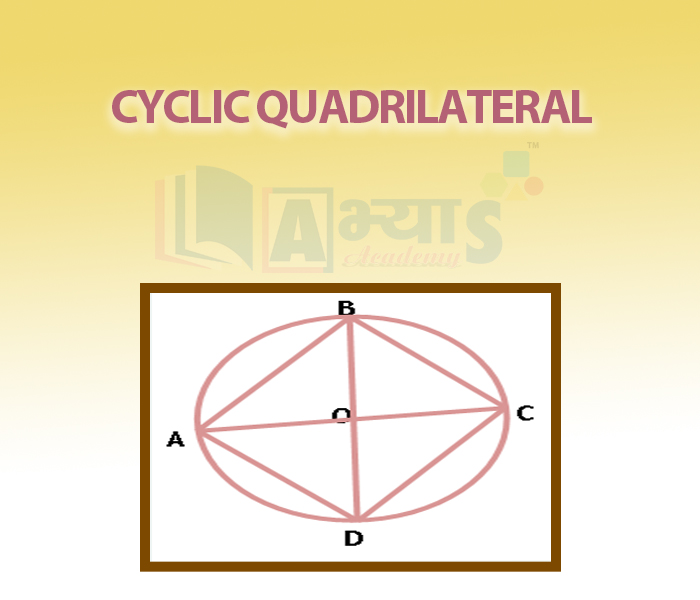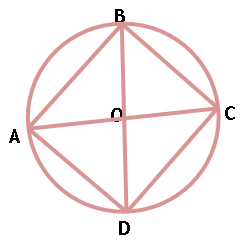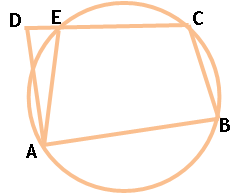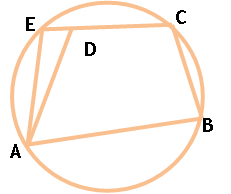Cyclic Quadrilateral













Cyclic Quadrilateral
CYCLIC QUADRILATERAL
DEFINITION A quadrilateral is called a cyclic quadrilateral if its all vertices lie on a circle.
A cyclic quadrilateral has some special properties which other quadrilaterals, in general, need not have . We shall state and prove these properties as theorems.
Theorem 1 The sum of either pair of opposite angles of a cyclic quadrilaterals is
OR
The opposite angles of a cyclic quadrilateral are supplementary.
Given A cyclic quadrilateral ABCD. TO PROVE CONSTRUCTION Join AC and BD. PROOF Consider side AB of quadrilateral ABCD as the chord of the circle. Clearly,
Now, consider the side BC of quadrilateral ABCD as the chord of the circle. We find that
Adding equations (i) and (ii) , we get
Hence, The converse of this theorem is also true as given below. |  |
Converse Theorem: If the sum of any pair of opposite angles of a quadriletral is | |
Given: A quadrilateral ABCD in which Tp Prove: ABCD is a cyclic quadrilateral Construction: Draw a circle passing through A, B and C. Proof: Suppose the circle meets CD or CD produced at E. Join AE Now ABCE is a cyclic Quadrilateral. As Opposite angles of a cyclic quadrilateral are supplementary
But, From Equation (1) and (2) we get But this is not possible And we know that the exterior angle of a triangle is equal to sum of interior opposite angles That is exterior angle is always greater than interior opposite angle Thus our assumption is wrong Hence ABCD is a cyclic quadrilateral. |
Case (1)
Case (2) |
| Illustration: In the figure ACDF is a cyclic quadrilateral. A circle passing through A and F meets AC and DF in the points B and E respectively. Prove that BE || CD. | |
Solution: ACDF is a cyclic quadrilateral and In a cyclic quadrilateral opposite angles are supplementary
Also ABEF is a cyclic quadrilateral and In a cyclic quadrilateral opposite angles are supplementary
From Equation 1 and 3 we get But they are corresponding angles when BE and CD are two straight lines and BC is the transversal As they are equal, So BE || CD |  |
From the figure below, identify the correct relation
| |||
| Right Option : B | |||
| View Explanation | |||
Identify the correct relationship from the figure below
| |||
| Right Option : D | |||
| View Explanation | |||
Students / Parents Reviews [20]
One of the best institutes to develope a child interest in studies.Provides SST and English knowledge also unlike other institutes. Teachers are co operative and friendly online tests andPPT develope practical knowledge also.

Aman Kumar Shrivastava
10thMy experience with Abhyas is very good. I have learnt many things here like vedic maths and reasoning also. Teachers here first take our doubts and then there are assignments to verify our weak points.

Shivam Rana
7thAbhyas Methodology is very good. It is based on according to student and each child manages accordingly to its properly. Methodology has improved the abilities of students to shine them in future.

Manish Kumar
10thA marvelous experience with Abhyas. I am glad to share that my ward has achieved more than enough at the Ambala ABHYAS centre. Years have passed on and more and more he has gained. May the centre flourish and develop day by day by the grace of God.

Archit Segal
7thUsually we see institutes offering objective based learning which usually causes a lag behind in subjective examinations which is the pattern followed by schools. I think it is really a work of planning to make us students grab the advantages of modes of examination, Objective Subjective and Onli...

Anika Saxena
8thIn terms of methodology I want to say that institute provides expert guidence and results oriented monitering supplements by requsite study material along with regular tests which help the students to improve their education skills.The techniques of providing education helps the students to asses...

Aman Kumar Shrivastava
10thAbout Abhyas metholodology the teachers are very nice and hardworking toward students.The Centre Head Mrs Anu Sethi is also a brilliant teacher.Abhyas has taught me how to overcome problems and has always taken my doubts and suppoeted me.

Shreya Shrivastava
8thAbhyas is a complete education Institute. Here extreme care is taken by teacher with the help of regular exam. Extra classes also conducted by the institute, if the student is weak.

Om Umang
10thMy experience was very good with Abhyas academy. I am studying here from 6th class and I am satisfied by its results in my life. I improved a lot here ahead of school syllabus.

Ayan Ghosh
8thAbhyas academy is great place to learn. I have learnt a lot here they have finished my fear of not answering.It has created a habit of self studying in me.The teachers here are very supportive and helpful. Earlier my maths and science was good but now it has been much better than before.

Barkha Arora
10thMy experience with Abhyas Academy has been very good. When I was not in Abhyas whenever teacher ask questions I could not speak it confidently but when I came in Abhyas, my speaking skills developed and now I am the first one to give the answer of teachers question.

Upmanyu Sharma
7thMy experience with Abhyas academy is very good. I did not think that my every subject coming here will be so strong. The main thing is that the online tests had made me learn here more things.

Hiya Gupta
8thAbhyas is good institution and a innovative institute also. It is a good platform of beginners.Due to Abhyas,he has got knoweledge about reasoning and confidence.My son has improved his vocabulary because of Abhyas.Teacher have very friendly atmosphere also.

Manish Kumar
10thWe started with lot of hope that Abhyas will help in better understnding of complex topics of highers classes. we are not disappointed with the progress our child has made after attending Abhyas. Though need to mention that we expected a lot more. On a scale of 1-10, we would give may be 7.

Manya
8thMy experience with Abhyas academy is very nice or it can be said wonderful. I have been studying here from seven class. I have been completing my journey of three years. I am tinking that I should join Abhyas Academy in tenth class as I am seeing much improvement in Maths and English

Hridey Preet
9thIt was a good experience with Abhyas Academy. I even faced problems in starting but slowly and steadily overcomed. Especially reasoning classes helped me a lot.

Cheshta
10thAbhyas institute is one of the best coaching institute in the vicinity of Ambala Cantt area. The teachers of the institute are well experienced and very helpful in solving the problems of the students.The good thing of the institute is that it is providing extra classes for the students who are w...

Aman Kumar Shrivastava
10thBeing a parent, I saw my daughter improvement in her studies by seeing a good result in all day to day compititive exam TMO, NSO, IEO etc and as well as studies. I have got a fruitful result from my daughter.

Prisha Gupta
8thThird consective year,my ward is in Abhyas with nice experience of admin and transport support.Educational standard of the institute recumbent at satisfactory level. One thing would live to bring in notice that last year study books was distributed after half of the session was over,though study ...

Ayan Ghosh
8thI have spent a wonderful time in Abhyas academy. It has made my reasoning more apt, English more stronger and Maths an interesting subject for me. It has given me a habbit of self studying


